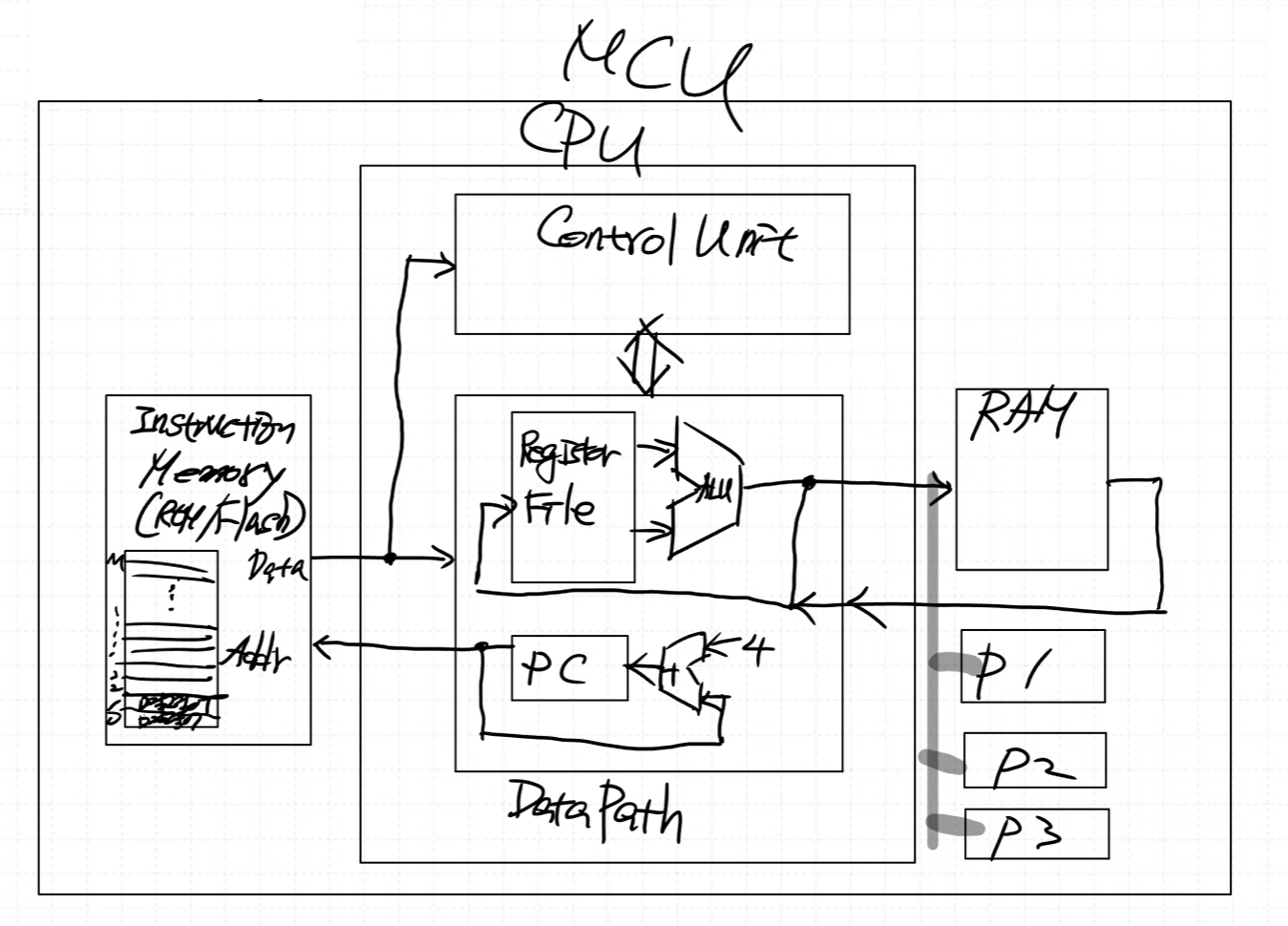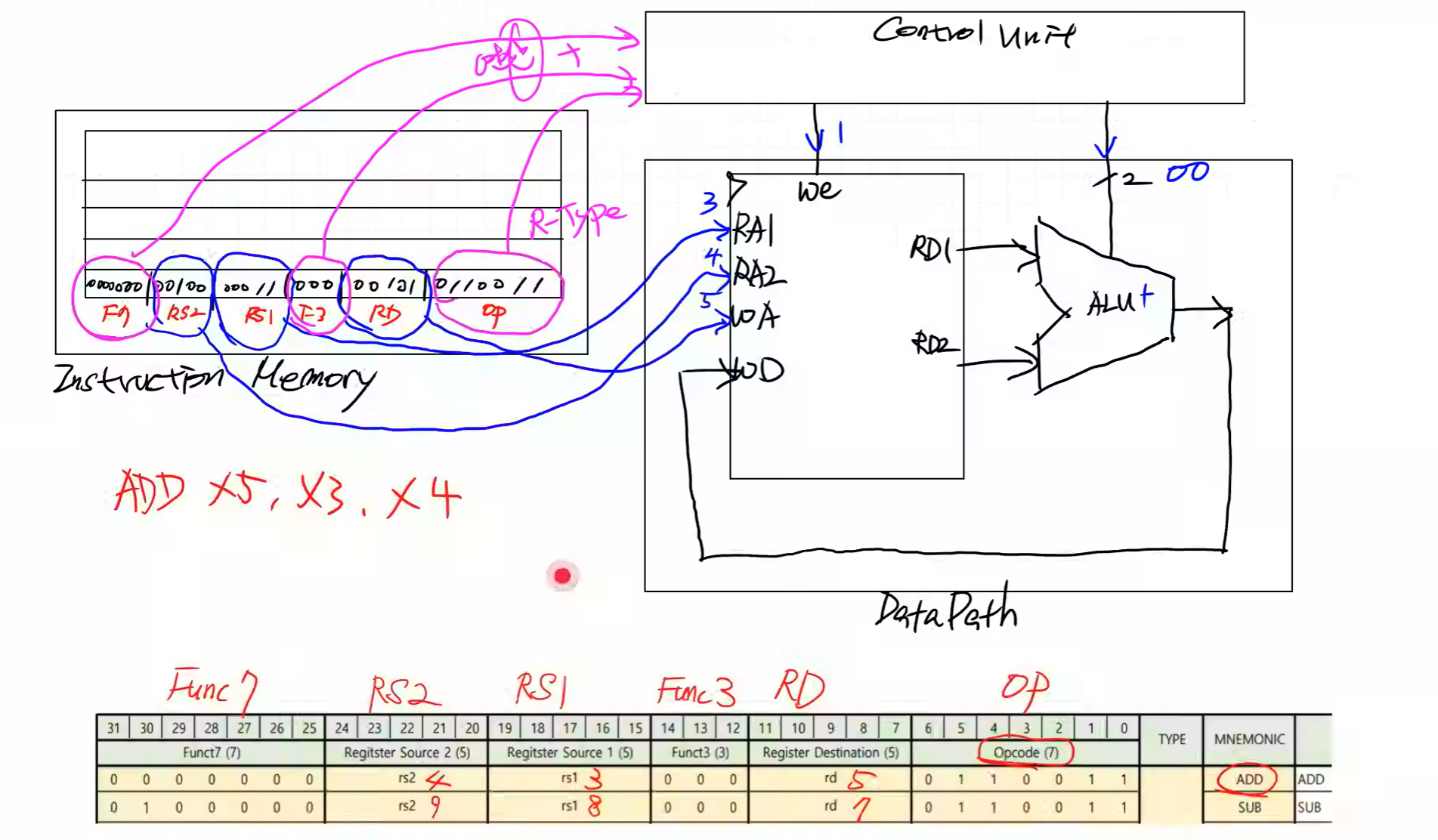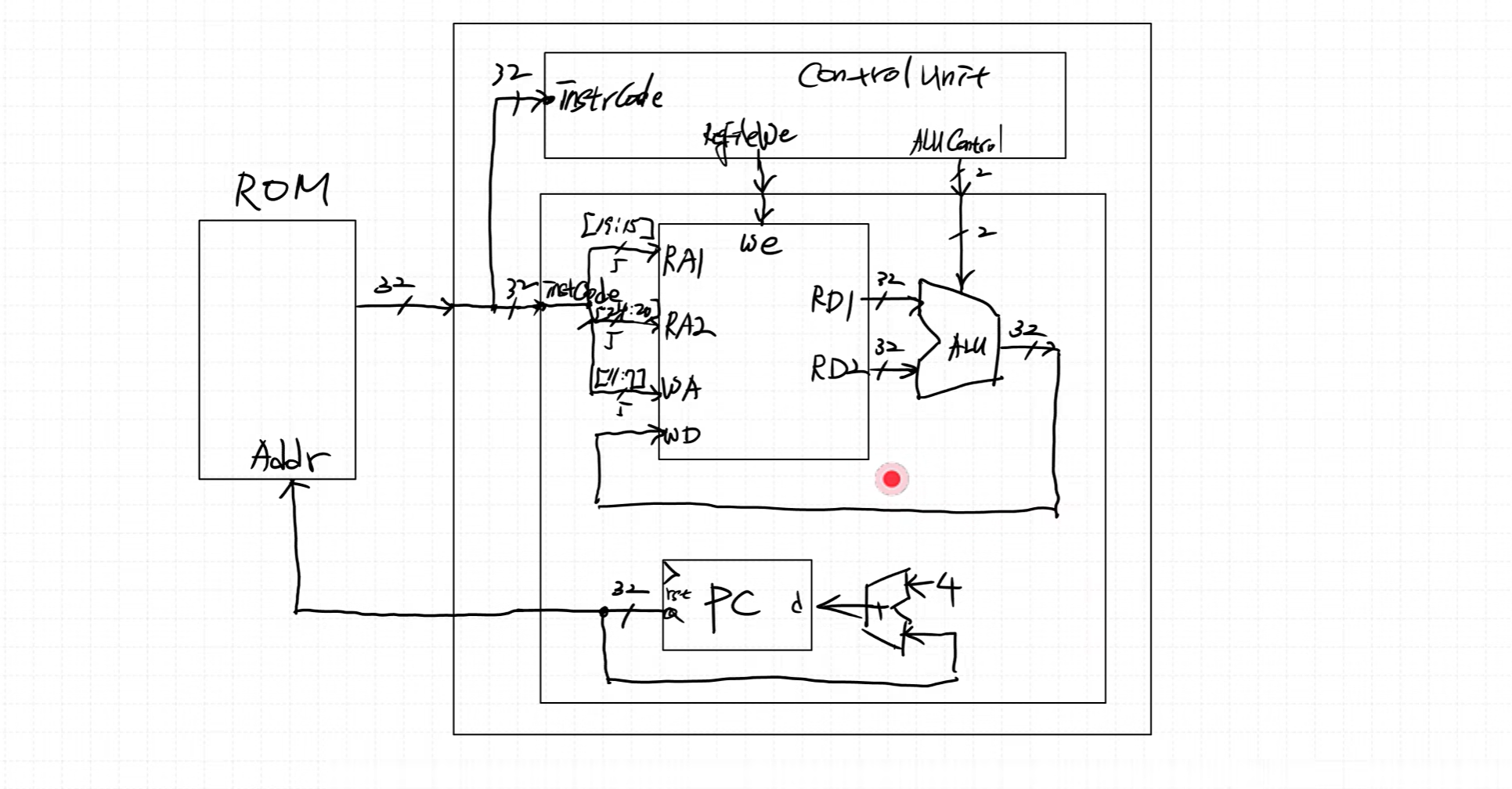RISC-V Design
RISC-V (리스크 파이브)
2010년부터 미국 UC 버클리에서 개발 중인 무료 오픈 소스 RISC 명령어셋 아키텍처
- Base: RV32I
- Version: 2.0
1. Single-Cycle Architecture
- 모든 명령어가 1 clock에 동작
- 가장 시간이 오래 걸리는 명령어를 기준으로 클럭 주기를 설계해야 함
- 장점: 구조가 매우 단순함
- 단점: 전체 실행 속도가 느림
2. Multi-Cycle Architecture
- 명령어 유형(type)에 따라 필요한 clock 수가 다름
- 명령어에 따라 실행 시간을 단축할 수 있음
- 장점: Single-Cycle보다 빠름
- 단점: 구조가 다소 복잡함
구현 목표
① Single-Cycle로 먼저 구현 및 이해
② Multi-Cycle로 전환 + ARMA BUS + 주변장치(Peripherals) 연동
3. Pipeline Architecture (현재 구현 X)
- 장점: Single-Cycle보다 훨씬 빠름
- 단점: 구조가 매우 복잡함

- x0 → zero : 항상 0 값을 가지는 레지스터
- x1 → ra (Return Address) : 함수 호출 후 복귀 주소 저장
- x2 → sp (Stack Pointer) : 스택의 최상단 주소 저장
- x3 → gp (Global Pointer) : 전역 변수 접근용 포인터
- … (이후 x31까지 각자 용도 지정)
→ 어셈블리어에서는 x0, x1 대신 zero, ra, sp, gp 등의 별칭(alias)으로 표기됨
CPU 기본 모듈 (하버드 구조)
- Register File
→ CPU 내부 레지스터 집합, 연산 및 데이터 임시 저장 - ALU (Arithmetic Logic Unit)
→ 산술 및 논리 연산 수행 - ROM / Flash (Instruction Memory)
→ 프로그램 명령어 저장
※ ROM은 한 번 쓰면 지울 수 없으므로, 대부분 Flash 메모리(비휘발성) 사용 - RAM (Data Memory)
→ 프로그램 실행 중 데이터 임시 저장 (휘발성) - PC (Program Counter)
→ 현재 실행 중인 명령어의 주소를 가리키는 레지스터

Instruction, CPU, RAM 까지 Single-Cycle 구현
Peri는 Multi-Cycle 이후 구현
Block Diagram

Signal 이해

- Register Source 1 (5) : 5bit RS1
- Register Source 2 (5) : 5bit RS2
- Register Destination (5) : 5bit RD
- Opcode (7) : 7bit type 구분
- Funct7 (7) : 7bit 연산 구분
- Funct3 (3) : 3bit 연산 구분

ADD : rd(WAddr) = rs1(RA1) + rs2(RA2) / add : x7(rd), x5(rs1), x6(rs2) = x7 = x5(Data) + x6(Data)

< Data Path >

< Code : Data Path >
`timescale 1ns / 1ps
module DataPath (
input logic clk,
input logic reset,
input logic [31:0] instrCode,
input logic regFileWe,
input logic [ 1:0] aluControl,
output logic [31:0] instrMemAddr
);
logic [31:0] aluResult, RFData1, RFData2;
logic [31:0] PCSrcData, PCOutData;
assign instrMemAddr = PCOutData;
RegisterFile U_RegFile (
.clk(clk),
.we (regFileWe),
.RA1(instrCode[19:15]),
.RA2(instrCode[24:20]),
.WA (instrCode[11:7]),
.WD (aluResult),
.RD1(RFData1),
.RD2(RFData2)
);
alu U_ALU (
.aluControl(aluControl),
.a (RFData1),
.b (RFData2),
.result (aluResult)
);
register U_PC (
.clk (clk),
.reset(reset),
.en (1'b1),
.d (PCSrcData),
.q (PCOutData)
);
adder U_PC_Adder (
.a(32'd4),
.b(PCOutData),
.y(PCSrcData)
);
endmodule
module alu (
input logic [ 1:0] aluControl,
input logic [31:0] a,
input logic [31:0] b,
output logic [31:0] result
);
always_comb begin
result = a + b;
case (aluControl)
2'b00: result = a + b;
2'b01: result = a - b;
2'b10: result = a & b;
2'b11: result = a | b;
endcase
end
endmodule
module RegisterFile (
input logic clk,
input logic we,
input logic [ 4:0] RA1,
input logic [ 4:0] RA2,
input logic [ 4:0] WA,
input logic [31:0] WD,
output logic [31:0] RD1,
output logic [31:0] RD2
);
logic [31:0] mem[0:2**5-1];
always_ff @(posedge clk) begin
if (we) mem[WA] <= WD;
end
assign RD1 = (RA1 != 0) ? mem[RA1] : 32'b0;
assign RD2 = (RA2 != 0) ? mem[RA2] : 32'b0;
endmodule
module register (
input logic clk,
input logic reset,
input logic en,
input logic [31:0] d,
output logic [31:0] q
);
always_ff @(posedge clk, posedge reset) begin
if (reset) begin
q <= 0;
end else begin
if (en) q <= d;
end
end
endmodule
module adder (
input logic [31:0] a,
input logic [31:0] b,
output logic [31:0] y
);
assign y = a + b;
endmodule
< Schematic : DataPath >

< Code : Control Unit >
`timescale 1ns / 1ps
module ControlUnit (
input logic [31:0] instrCode,
output logic regFileWe,
output logic [ 1:0] aluControl
);
// logic 은 선언하면서 연결이 안되기 때문에 wire 사용 (logic 사용시 assign 필요)
wire [6:0] opcode = instrCode[6:0];
wire [3:0] operator = {instrCode[30], instrCode[14:12]};
always_comb begin
regFileWe = 1'b0;
case (opcode)
7'b0110011: regFileWe = 1'b1;
endcase
end
always_comb begin
aluControl = 2'bx;
case (opcode)
7'b0110011: begin // R-Type
aluControl = 2'bx;
case (operator)
4'b0000: aluControl = 2'b00; // add
4'b1000: aluControl = 2'b01; // sub
4'b0111: aluControl = 2'b10; // and
4'b0110: aluControl = 2'b11; // or
endcase
end
endcase
end
endmodule
< Code : CPU_RV32I >
`timescale 1ns / 1ps
module CPU_RV32I (
input logic clk,
input logic reset,
input logic [31:0] instrCode,
output logic [31:0] instrMemAddr
);
logic regFileWe;
logic [1:0] aluControl;
ControlUnit U_ControlUnit (.*);
DataPath U_DataPath (.*);
endmodule
< Schematic : CPU_RV32I >

< Code : ROM >

`timescale 1ns / 1ps
module ROM (
input logic [31:0] addr,
output logic [31:0] data
);
logic [31:0] rom[0:61];
initial begin
//rom[x]=32'b func7 _ rs2 _ rs1 _f3 _ rd _ op
rom[0] = 32'b0000000_00001_00010_000_00100_0110011; // add x4, x2, x1
rom[1] = 32'b0100000_00001_00010_000_00101_0110011; // sub x5, x2, x1
rom[2] = 32'b0000000_00000_00011_111_00110_0110011; // and x6, x3, x0
rom[3] = 32'b0000000_00000_00011_110_00111_0110011; // or x7, x3, x0
end
// 하위 2bit 를 없애면 4(2^2)의 배수로 표현이 됨, 4byte 단위로 이동 가능
assign data = rom[addr[31:2]];
endmodule
< Code : MCU >
`timescale 1ns / 1ps
module MCU (
input logic clk,
input logic reset
);
logic [31:0] instrCode;
logic [31:0] instrMemAddr;
ROM U_ROM (
.addr(instrMemAddr),
.data(instrCode)
);
CPU_RV32I U_CPU_RV32I (.*);
endmodule
< Schematic : MCU >

< Simulation >


< 파일 >
sources (Class)
sim (Class)
HW
< Design Specification >

- RISC-V RV32I R-Type 명령어 설계
< Code : DataPath (alu) >
//...
module alu (
input logic [ 3:0] aluControl,
input logic [31:0] a,
input logic [31:0] b,
output logic [31:0] result
);
always_comb begin
result = 32'b0;
case (aluControl)
4'b0000: result = a + b;
4'b0001: result = a - b;
4'b0010: result = a << b;
4'b0011: result = a >> b;
4'b0100: result = a >>> b;
4'b0101: result = ($signed(a) < $signed(b)) ? 1 : 0;
4'b0110: result = (a < b) ? 1 : 0;
4'b0111: result = a ^ b;
4'b1000: result = a | b;
4'b1001: result = a & b;
endcase
end
endmodule
//...
< Code : ControlUnit >
`timescale 1ns / 1ps
module ControlUnit (
input logic [31:0] instrCode,
output logic regFileWe,
output logic [ 3:0] aluControl
);
// logic 은 선언하면서 연결이 안되기 때문에 wire 사용 (logic 사용시 assign 필요)
wire [6:0] opcode = instrCode[6:0];
wire [3:0] operator = {instrCode[30], instrCode[14:12]};
always_comb begin
regFileWe = 1'b0;
case (opcode)
7'b0110011: regFileWe = 1'b1;
endcase
end
always_comb begin
aluControl = 4'bx;
case (opcode)
7'b0110011: begin // R-Type
aluControl = 4'bx;
case (operator)
4'b0000: aluControl = 4'b0000; // ADD
4'b1000: aluControl = 4'b0001; // SUB
4'b0001: aluControl = 4'b0010; // SLL
4'b0101: aluControl = 4'b0011; // SRL
4'b1101: aluControl = 4'b0100; // SRA
4'b0010: aluControl = 4'b0101; // SLT
4'b0011: aluControl = 4'b0110; // SLTU
4'b0100: aluControl = 4'b0111; // XOR
4'b0110: aluControl = 4'b1000; // OR
4'b0111: aluControl = 4'b1001; // AND
endcase
end
endcase
end
endmodule
< Code : ROM >
`timescale 1ns / 1ps
module ROM (
input logic [31:0] addr,
output logic [31:0] data
);
logic [31:0] rom[0:61];
initial begin
//rom[x]=32'b func7 _ rs2 _ rs1 _f3 _ rd _ op
rom[0] = 32'b0000000_00010_00001_000_00011_0110011; // add x3, x1, x2
rom[1] = 32'b0100000_00010_00001_000_00011_0110011; // sub x3, x1, x2
rom[2] = 32'b0000000_00010_00001_001_00011_0110011; // sll x3, x1, x2
rom[3] = 32'b0000000_00010_00001_101_00011_0110011; // srl x3, x1, x2
rom[4] = 32'b0100000_00010_00001_101_00011_0110011; // sra x3, x1, x2
rom[5] = 32'b0000000_00010_00001_010_00011_0110011; // slt x3, x1, x2
rom[6] = 32'b0000000_00010_00001_011_00011_0110011; // sltu x3, x1, x2
rom[7] = 32'b0000000_00010_00001_100_00011_0110011; // xor x3, x1, x2
rom[8] = 32'b0000000_00010_00001_110_00011_0110011; // or x3, x1, x2
rom[9] = 32'b0000000_00010_00001_111_00011_0110011; // and x3, x1, x2
end
// 하위 2bit 를 없애면 4(2^2)의 배수로 표현이 됨, 4byte 단위로 이동 가능
assign data = rom[addr[31:2]];
endmodule
< Simulation >

< 파일 >
sources (HW)
sim (HW)
